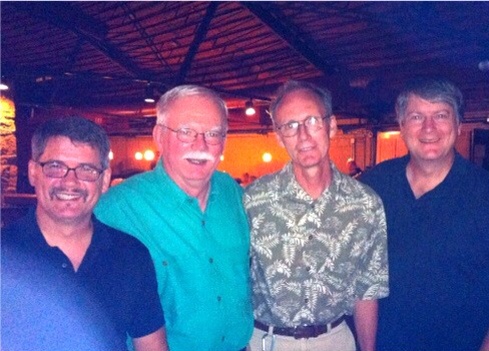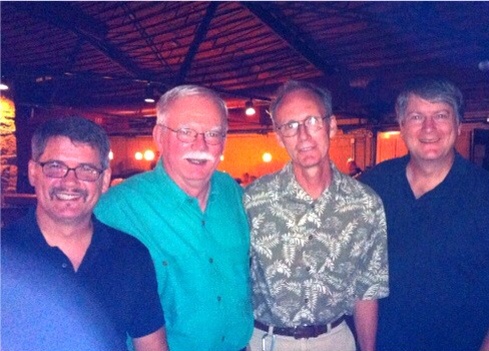By Mary Fairchild Rob Sula, Dr. Frederick R. Schram, Jack Wittry, Jim Fairchild.–August, 2011.
Rob Sula, Dr. Frederick R. Schram, Jack Wittry, Jim Fairchild.–August, 2011.
The Mazon Creek site is very significant because of the diversity of life compared to other
Lagerstatten. Frederick R. Schram (2)
In August, ESCONI members Rob and Sondra Sula, Jack and Charlene Wittry, and Jim and I met with Dr. Frederick Schram at the Two Brothers Roundhouse in Aurora, Illinois. Dr. Frederick Schram had been spending some time at the Field Museum where, in 1965, he first began his work with Mazon Creek fossils as a graduate student. The Field Museum’s collection is considered the most comprehensive collection of Mazon Creek fossils.
Dr. Frederick R. Schram is a paleontologist and carcinologist who has roots in the The Mazon Creek Project. Schram received his B.S. in biology from Loyola University in 1965, and a Ph.D. on palaeozoology from the University of Chicago in 1968 and has written over 200 papers on various aspects of crustacean biology, taxonomy and systematics, as well as several books, including the standard text Crustacea. He also wrote a chapter on crustaceans in The Richardson’s Guide to the Fossil Fauna of Mazon Creek. (1)
In 1983, Schram founded the journal Crustacean Issues, which he continued to edit for over twenty years. Much of his career has been spent at the University of Amsterdam, the Netherlands, from which he retired in 2005. In July 2005, he became the Editor of the Journal of Crustacean Biology which is a peer-reviewed scientific journal in the field of carcinology (crustacean research).
In the fall of 2006, Schram was the special guest speaker at the Mazon Creek Open House hosted at the Lizzadro Museum in Elmhurst. The night before, he spoke at the ESCONI General Meeting and discussed his roots in the The Mazon Creek Project:
Forty years ago, Gene Richardson and Ralph Gordon Johnson were the founders of the first real Mazon Creek study in Braidwood. George Langford structured the project and was able to get grant money for it.
Ferns were always plentiful, but Gene Richardson chose to do his PhD at Princeton on the insects of Mazon Creek. In 1958 Mr. Tully came to the Field Museum with his Tully Monster.
In 1965 Fred Schram arrived. He was was a graduate student of Ralph Gordon Johnson and he described two faunas of Braidwood clams.
Then June Douglas(Mother of Dave Douglas of Dave’s Down to Earth Rock Shop) found the first coleiod cephelopd that was published in Science and funds started to come in. Gene Richardson was focused on working with amateurs and was a gracious diplomat. He worked well with amateur collectors as he tried to build up the Field collection.
When they began to put more field crews from the Museum into the field to collect,Charlie Shabica was the field boss of the students and Milburn MacKay was the Peabody geologist on the site. Many of the people involved then have gone on to noteworthy careers today.
Charlie Shabica, a specialist in regional geology, developed how Pit 11 was deposited in a Pennsylvanian-deltaic model.
Ida Thompson developed an early interest in annelid worms and did a monograph on polychaete worms.
Jim Edwards went to the National Science Foundation and then to become the Director of GBIF in Copenhagen.
Richard Wassersug is Professor of Biology at Dalhousie in Nova Scotia.
After the 1960s Ralph Johnson and Gene Richardson ended their partnership. Gene remained with Mazon Creek and Ralph moved on to other projects. Gordon Baird mapped Mazon Creek in the 1970’s. Gene retired in 1983 and died shortly thereafter and the Mazon Creek Project moved to Northeastern Illinois University. Later an NSF grant to the Field Museum in the late 1980’s with Brent Beall was to catalog the massive collection. This was a chance for Schram to rewrite his dissertation. Frederick Schram (2)
The Mazon Creek area includes the following counties of Northeastern Illinois: Will, Grundy, Kankakee, LaSalle, and Livingston. The fossils are preserved in ironstone concretions or nodules which preserved many soft-bodied animals and plants that are rarely fossilized. During the Pennsylvanian this area of Illinois was covered with coastal swamps, deltas, and upland forests situated along an estuary bay. The fossils include animals and plants that lived in the surrounding swamps and forests; as well as animals that lived in fresh and brackish water of the rivers, ponds, and estuary; and some marine animals that lived in the shallow sea covering Western Illinois. The Field Museum’s collection is the most comprehensive collection of these fossils. (5)
Mazon Creek fossils are most complete known record of late Paleozoic life. These extraordinary fossils rank impressively alongside with the Cambrian Burgess Shale fauna of Canada, the Devonian Bundenbach and Jurassic Solnhofen faunas of Germany, and the Cretaceous Santana fauna of Brazil. (3)
References
1. Frederick R. Schram; Wikipedia.
2. 11/10/06, ESCONI Newsletter.
3. Mazon Creek Fossils
4. The Mazon Creek Project
5. Mazon Creek Fossil Invertebrates ; The Field Museum.
6. Dave’s Down to Earth Rock Shop; Evanston, Illinois.
7. Mazon Creek Fossils; Illinois State Museum.
Related
Dinosaur Bone Hunting(Wyoming; South Dakota; Paleo Prospectors)
ESCONI Rock Club: If I Could Turn Back Time
Mid-America Paleontology Society Annual Fossil Show Moves to Iowa
Sea Change and Sea Kayaking (Door County; Dolostone; Niagara Escarpment; Mazon Creek Book)

